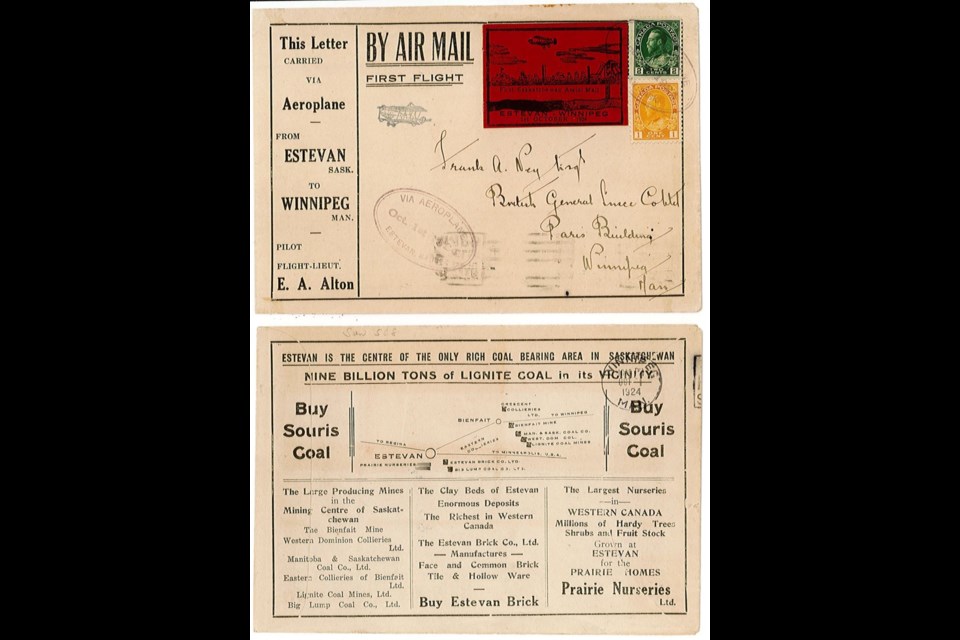ESTEVAN — Saskatchewan's historic first airmail flight, departing from Estevan Oct. 1, 1924, may have ended in a crash, but the story of that bold attempt continues to live on, thanks to people like Ken Turner.
A dedicated collector with a deep interest in Estevan's history, Turner has spent decades acquiring and preserving rare airmail covers and stamps associated with the flight that aimed to connect Saskatchewan to the world.
"I honestly didn't know these covers were out there," Turner recalled, discussing his early discoveries.
One such cover he stumbled upon at a sale in Minot, N.D., sparked his fascination. It was a cover without the distinct red stamp, but it was the one that started his research and collection.
Years later he was able to find covers with the red stamps on them, and also learned more about the flight itself, as a collector in Saskatoon was able to summarize what happened in Estevan in 1924.
The flight itself was meant to bring attention to Estevan's burgeoning coal industry by delivering mail to Winnipeg via airplane. Despite meticulous planning, mechanical trouble forced the pilot to crash land near Bienfait. The mail, however, continued its journey by train. This mishap, far from diminishing the historical importance of the flight, has added a layer of intrigue for collectors like Turner.
Turner was also able to find an article published in the Mercury on Oct. 2, 1924, detailing the entire endeavour.
For Turner, collecting these covers is more than just a hobby; it's about preserving a unique slice of Saskatchewan's history.
"These stamps are part of Saskatchewan history," he explained, showing how mail-related artifacts can offer a different perspective on the past.
He continues to search for more airmail covers, adding to his growing collection and keeping the memory of this pioneering flight alive. These artifacts also sparked his interest in Saskatchewan postal cards and other mail-related pieces.
"I got interested in stuff that was in Estevan, so I tumbled into that area. And you just keep adding the piece that you stumble across at a show or someplace," he explained.
Turner asked anyone who has covers, postcards or stamps related to the 1924 airmail flight to contact him at 306-421-2568.
"It'd be interesting to see who has them, how they got them or whatever they did with them," he noted.
This week marks the centennial anniversary of the pioneering airmail flight from Estevan to Winnipeg. Commissioned by C.A. Manlove, an Estevan insurance agent, the venture was designed to promote the town's industrial potential, particularly its lignite coal resources, to federal and international audiences.
The journey, piloted by Flight Lt. Alton, was expected to put Estevan on the global stage by sending out specially stamped letters to key figures, including lieutenant governors of Canadian provinces, the Prince of Wales, Her Royal Highness, Winnipeg city council, the Winnipeg Rotary Club and philatelic societies around the world. It also included mail for friends and family of Estevan residents. The mailbag contained 1,926 packages, all marked with special cancellations commemorating the flight, making them highly valuable for stamp collectors.
Manlove envisioned this flight as a way to draw attention to Estevan's economic opportunities – particularly for Winnipeg fuel consumers with the lignite fields of this district – and the interest of foreign investors in the agriculture and industrial development of this rich area of the North American mid-west. The mail carried messages to dignitaries, while its packaging featured maps and information on local industries like coal mining, brick production and more.
Unfortunately, despite favourable weather and Lt. Alton's meticulous preparations, the flight encountered mechanical trouble shortly after takeoff. The aircraft was forced to land on a field near Bienfait, when it struck a hidden rock pile, damaging its wings. Alton and the flight mechanic made it out safely. Despite the crash, Alton ensured the mail reached Winnipeg thanks to a passing train.
While the crash was disappointing, particularly for its potential impact on promoting airmail service, the event remained a notable moment in Saskatchewan's aviation and postal history. Estevan's attempt at airmail delivery failed, but the mishap has not diminished the value of the special packages. And even though Manlove's ambitious initiative may not have fully succeeded, it still managed to place Estevan on the international map, albeit in a more subdued fashion.






